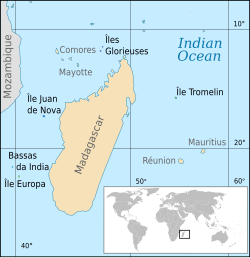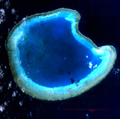Bassas da India
21°28′57″S 39°40′19″E / 21.48250°S 39.67194°E
Bassas da India Bassas da India | |
|---|---|
|
Flag | |
| Motto: "Liberté, égalité, fraternité" | |
| Anthem: La Marseillaise | |
 Location of the Scattered islands in the Indian Ocean.
|
Bassas da India is an uninhabited, roughly circular French atoll that is part of the French Southern and Antarctic Lands. Located in the southern Mozambique Channel, about halfway between Mozambique and Madagascar (about 385 km (239 mi) further east) and around 110 km (68 mi) northwest of Europa Island, the rim of the atoll averages around 100 m in width and encloses a shallow lagoon of depth no greater than 15 m. Overall, the atoll is about 10 km (6 mi) in diameter, rising steeply from the seabed 3000 m below to encircle an area (including lagoon) of 80 km2 (31 sq mi). Its exclusive economic zone (EEZ), 123,700 km2 (47,761 sq mi) in size, is contiguous with that of Europa Island.
The atoll consists of ten barren rocky islets, with no vegetation, totalling 0.2 km² (.077 sq mi) in area. Those on the north and east sides are 2.1 to 3 m high, while those on the west and south sides are 1.2 m high. The reef, whose coastline measures 35.2 km (22 mi), is completely covered by the sea from three hours before high tide to three hours afterward. The region is also subject to cyclones, making the atoll a long-time maritime hazard and the site of numerous shipwrecks.
Jaguar Seamount and Hall Tablemount lie, respectively, about 40 and 70 km further southwest.
Gallery
-
Detailed map.
-
ISS photograph.
-
Landsat 7 image.
-
CIA WFB map.
-
CIA map.
-
ISS image of Bassas da India with varying degrees of sunglint.
History
The Bassas da India was first recorded by Portuguese explorers in the early sixteenth century as the "Baixo da Judia" ("Jewess Shoals"). The Judia ("Jewess", for the ancestry of its owner Fernão de Loronha[1]) was the Portuguese ship that discovered the feature by running aground on it in 1506.[2] The name became "Bassas da India" due to transcription errors by cartographers. The Santiago broke up on the shoal in 1585.
It was rediscovered by the Europa in 1774, whence the name "Europa Rocks".[3] The Malay was lost 27 July 1842 on the Europa Rocks.[4]
In 1897, the shoal became a French possession, later being placed under the administration of a commissioner residing in Réunion in 1968. Madagascar became independent in 1960 and claims sovereignty over the shoal since 1972.
Tourism
Mooring at Bassas da India requires a permit from the French Government.[5] Fishing without such a permit may result in the boat being expelled or even confiscated.[6] Several illegal tourism charters departing from Mozambique or South Africa have been seized since 2013 by the French navy.[7] [8]
References
- ^ Bernardo Gomes de Brito. Historia Tragico-Maritima. Em que se escrevem chronologicamente os Naufragios que tiverão as Naos de Portugal, depois que se poz em exercicio a Navegação da India. Lisboa 1735
- ^ Natal Museum. Natal Museum journal of humanities, Vol. 12. The Museum Council (Pietermaritzburg), 2000.
- ^ "...Europa [R]ocks, was [sic] discovered by the ship Europa in 1774." In Africa pilot, Part 3 Hydrographic Office of Great Britain.
- ^ Historical Sketch of Salem, 1626–1879.
- ^ Template:Fr icon Iles Eparses Access
- ^ Template:Fr icon 5 July 1983 French Law
- ^ French navy near Bassas da India
- ^ French_Navy Bassas_da_India_2014
Further reading
- Warne, Kennedy (April 2014). "A tale of two atolls". National Geographic. pp. 62–75.
External links
 Wikimedia Atlas of Bassas da India
Wikimedia Atlas of Bassas da India- "Oceandots". Archived from the original on 23 December 2010. Retrieved 2009-03-14.
{{cite web}}: Unknown parameter|deadurl=ignored (|url-status=suggested) (help) - Sailing Directions: East Africa and the South Indian Ocean
- "French Southern and Antarctic Lands". The World Factbook (2024 ed.). Central Intelligence Agency..







